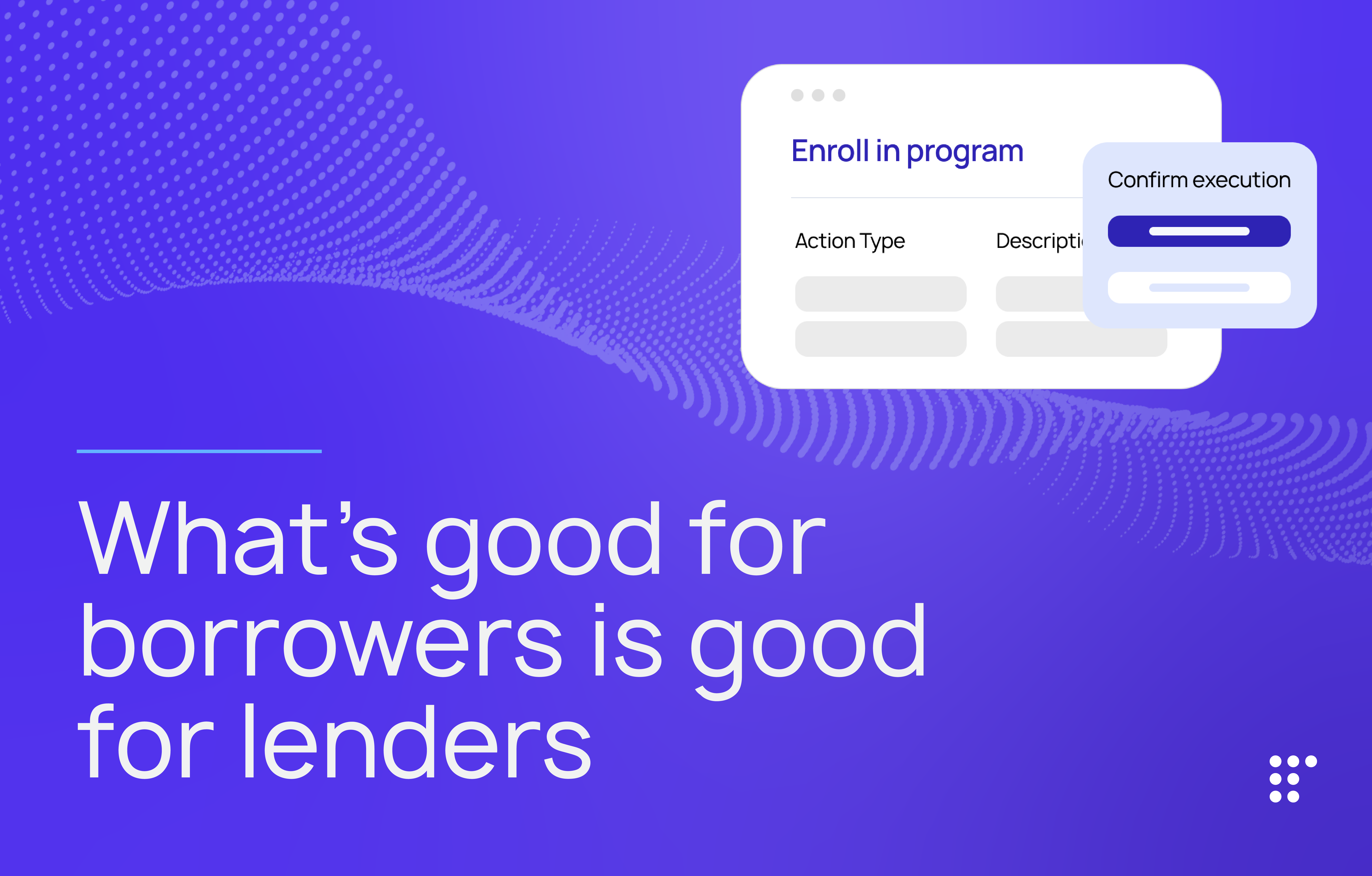How To Develop a Portfolio Management Strategy: A Guide
The Importance of Loan Portfolio Management (LPM)
When banks, credit unions, and other financial institutions conduct a loan review on a lending portfolio, they see tremendous potential—countless loans or lines of credit, all accruing interest even as they repay. But its worth remembering that a loan portfolio also represents significant risk. Every time you loan money, you’re taking on the possibility that you’ll never see it again.
Getting that money back is a matter of successfully managing your portfolio: Analyzing and mitigating risks, adhering to underwriting standards, building trust and transparency, and fine-tuning your operation to drive growth, retention, and profitability.
6 Steps To Develop a Successful LPM Strategy
These six steps will help financial institutions, lenders, and other companies to successfully manage their portfolio.
1. Understand How To Analyze a Loan Portfolio
Knowing, so they say, is half the battle. Failing to accurately assess your portfolio could mean that you’re overexposed to credit risk with risky loans that won’t pay you back, or that your payoffs all lie too close together, setting you up for liquidity problems down the road.
A good set of reporting dashboards, analytic tools, and thorough loan documentation are essential, and they can greatly simplify your analysis if they’re built in or integrated to your loan portfolio management software.
- Analyze your portfolio for the right blend of different accounts and customers. In good times and bad, a diverse portfolio will perform better than a monolith. Riskier loans with the possibility of large interest and fees can yield significant returns, but it’s best to balance them with more dependable borrowers. (And risky or dependable are of course relative, depending on the range of scores you focus on.)
- Analyze the timing for your account payoff, aiming to maintain a diffuse spread. Even if a majority of accounts are repaying, a lender may have gaps with limited liquidity if they’re all repaying on the same schedule. As you analyze your portfolio, consider the short-term and long-term payoff schedules, and how much funds you’ll in turn have for issuing new loans, cards, or lines of credit.
2. Analyze Loan Applications Beyond Their Credit Score
FICO credit scores are undeniably useful for consumers and financial institutions alike, but they aren’t a crystal ball that shows lenders an unshakeable future. Like any predictive metric, they have their limitations, the most obvious being applicants with thin credit files. For example, young people and people from outside the United States are likely to have a thin credit file, and consequently a deceptively low credit score.
The most immediate risk is that you reject an applicant who could have become a profitable customer. But even if you have approved them, you might still lose the opportunity if your proposed loan terms treat them like a delinquent borrower, with steep fees and higher interest rates. They might never accept your credit offer because they receive better terms from your competitors, who use alternative metrics to get a more comprehensive picture of their creditworthiness.
If you’re not supplementing FICO scores with those alternative metrics to evaluate credit quality, you’re losing business to any financial institution who does. Asking for pay stubs, checking with independent databases, or drawing on other information resources can bolster your confidence when extending credit.
For applicants sitting below your typical minimum credit score requirements, you can offer new credit products, outside of the traditional loans you offer to your ideal customer profiles. For example, a financial institution might offer conventional loans but with a higher interest rate or more stringent loan policy.
3. Foster a Culture of Trust and Transparency
An industry that revolves around giving people money and politely asking them to give it back later cannot work without trust between a financial institution and its borrowers. Developing a credit culture of trust and transparency sets your portfolio up for growth, success, and achieving your portfolio objectives.
Modern consumers are used to living in a world of radically different customer experiences. On the one hand, they’ve used some apps and programs that offer them total visibility into how they use the software and where their loan payments go, with more flexibility over significant aspects of their finances. Yet they also work with legacy infrastructure and experiences, where their data is kept out of sight and their time is wasted away listening to hold music. Many consumers have come to expect the legacy approach to financing (or worse, fearing predatory lenders), but elevating your borrower experience will do wonders for earning their trust.
Consider borrower-friendly loan policies. Flexible repayment terms—like hardship programs, adjusted payment schedules, or lower interest rates—have both the immediate potential to boost your collections rates, as well as the long-term effect of drawing in more customers and winning their loyalty. For example, some portfolio lenders have drawn in customers by ditching late fees, origination fees, and prepayment penalties. Online lenders can connect borrowers to loan funds faster by investing in a lending platform that can approve loan applications and deliver contracts on the same business day.
Self-serve tools also offer a refreshing dose of visibility and financial control. When customers need routine adjustments, like a due date change, most portfolio lenders will have them call in, taking up their servicing team’s time. Putting a ‘change due date’ button on a borrower website or app would save lenders time while giving borrowers faster access to changes. (And if you’re worried about some users abusing self-serve tools, maybe it’s time to upgrade your portfolio management software. Modern systems can limit them to eligible loans and line of credit accounts based on real-time data and your own custom business logic.)
4. Anticipate Potential Risks and Establish Mitigation Strategies
Because risk is inherent to lending, effective strategies for risk identification and mitigation are essential for portfolio management.
The first step, of course, lies with your credit offerings. Overextending into markets with higher risk is, to put it bluntly, risky. As discussed above, those risks may carry significant rewards for investors, but you can manage that inherent risk by balancing your portfolio with more stable products, offered to more dependable borrowers.
That same risk can also be mitigated through proactive collections strategies. For most consumer accounts, a missed due date is an anticipated breach of contract. A late fee will be automatically added, and many borrowers will manage to make their payment and get back on schedule. But when an account goes fully delinquent, many lenders have little strategy beyond sending more emails and adding more fees, until they eventually sell the account to another lender or a debt collector. Instead, they could mitigate default risk with dynamic collections strategies, adjusting payment schedules, interest rates, and other account terms to encourage repayment.
Compliance also poses an additional risk to your portfolio. The possibility of heavy fines creates a strong incentive to build iron-clad loan policies and strict portfolio management guidelines. But at the same time, volatility in Washington means that every election could bring a new swath of restrictions and requirements, demanding that your compliance strategy have more flexibility to accommodate dramatic changes. The solution, unfortunately, does not lie in a compromise between strict compliance and flexibility—compromising on either exposes you to fines and penalties. Instead, portfolio lenders should invest in a portfolio management software that can set strong policies, and then quickly and easily reconfigure them to adapt with new regulations.
5. Monitor KPIs To Improve Portfolio Performance
As you analyze your portfolio and take steps to mitigate risk, your key performance indicators (KPIs) can be the guideposts showing you where your efforts are proving effective, and where they need to be adjusted.
Ultimately, return on investment is the only KPI that really matters. Your portfolio’s success depends on bringing back more money than you initially gave out—no other metric matters if the portfolio loses money.
To effectively maintain profitability and discern where you could make meaningful improvements, you need to compare KPIs against each other. If collections rates are high, but ROI remains low, then efforts to further increase your collections rates may yield diminishing returns. Taken too far, overspending on collections efforts will reduce your ROI as the cost to collect on each account goes up. In those cases, you should instead look at streamlining and automating your collection process—lowering costs to boost margins.
Similarly, there are several KPIs in the application process that will compete for your attention (Customer Acquisition Cost, Application Pull-Through Rate, or Approved Account Abandonment to name a few.) These are all useful metrics, but only in the context of increasing your total number of accounts and enhancing financial performance.
6. Optimize for Loan Portfolio Growth
As you tune up your processes, it’s important to distinguish when a policy or guideline can measurably mitigate risk and reduce loss, and when those guidelines become obstacles to growth.
For instance, guidelines on debt-to-income ratios are of course important for avoiding unnecessary risk, but holding too strictly to those guidelines can limit growth. If a major opportunity for account growth arises, it’s worth considering whether your institution can step outside its usual guidelines. (That doesn’t mean to simply throw caution to the wind, though. If an exceptional opportunity leads you to take on more risk than usual, you also should look for ways to offset and mitigate it.)
Other portfolio lenders might restrict themselves to applicants who meet minimum credit score requirements. But borrowers without excellent credit can still be profitable. Instead of cutting them out entirely, consider allowing them to submit loan applications for a lower loan amount, or with higher interest rates. You might allow them to borrow on better loan terms if they submit joint applications with another borrower, or support their application with collateral.
The biggest limitation for the majority of portfolios is the cost of labor to service and collect on loans. Automation is your friend here. Automation can streamline servicing and collections tasks, enabling each agent to handle several times more loans, cards, and lines of credit than they could alone, while also improving asset quality. Empowering agents to handle a larger workload will open the doors to confident growth. For more on the benefits of automation, check out our article on The Power of Automating Your Online Lending.
Enhance Your Operations With the Best Loan Portfolio Management System
These portfolio management strategies are all important aspects of managing your portfolio, but none of them are simple—especially if you’re running on a weak system. Mediocre platforms offer financial institutions with subpar solutions to these problems, whether it’s a legacy solution whose UI still lives in the Clinton administration or a shiny newcomer that’s still developing their infrastructure and feature set.
Major operations need a powerful and modern credit platform, one with an architecture that enables both durability and growth in credit administration.
If you’re not quite sure what that lending platform would look like, check out our article on finding the best loan management software. Or if you’re more of a visual learner, we could just show you a demo.




